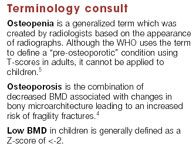Measuring bone density in children (CME)
Growing bones and shifting hormone levels make determining a child's bone density much like hitting a moving target. Fortunately, technologies are evolving to make this measurement more accurate. Evidence on which patients warrant this procedure is also building.

Key Points

Whom should we test?


Other patients should be assessed on an individual basis, taking into account the disease severity, duration, treatment, and degree of immobilization. Case in point: bone densitometry is generally not indicated in a normally-growing child with well-controlled asthma using minimal doses of inhaled steroids in the absence of fragility fractures. Conversely, a severe asthmatic requiring chronic or recurrent treatment with high-dose systemic steroids might warrant, at minimum, a baseline assessment of BMD as well as calcium/vitamin D studies. Baseline studies prior to the start of prolonged therapies containing anti-bone medications, such as steroids, may be useful for the monitoring of side effects and long-term follow-up. As with any investigation, the clinician should decide a priori if the results of the testing will direct the child's medical management.
How should we test them?
There are several available technologies for the assessment of bone mass. The ideal densitometer should be accurate, precise, fast, inexpensive, widely available, and expose the patient to minimal levels of radiation. It should be able to distinguish between cortical and trabecular bone, analyze bone architecture, estimate bone strength, and not be affected by a patient's unique characteristics, such as body fat or marrow abnormalities. Unfortunately, there is currently no one densitometer that meets all these criteria.
Most importantly, densitometers should have well-established reference data that correlate with fracture risk. While our understanding of the associations between bone density measurements and fracture risk in children is increasing,8,9 a fracture threshold based upon conventional densitometry has not yet been established.